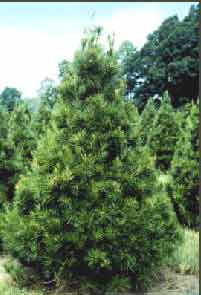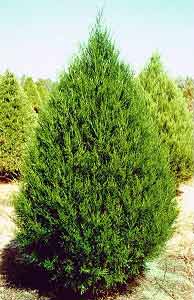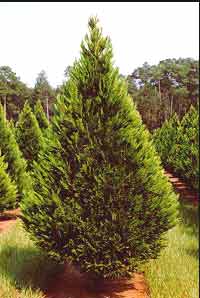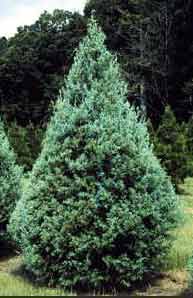

Christmas Trees | Fall Activities | Our Story | Links | Tree Stand | Home
"Sorry No Pets!"
Christmas
Tree Varieties
Following are basic descriptions of trees grown at May-Lan Tree Plantation. Availability varies from year to year, so if you are uncertain, please call.
We encourage you to review our “Proper Care of Your Real Tree” page as we are sure it will add enjoyment to the use of your Christmas centerpiece.
 Virginia Pine - The Virginia pine is a
native to South Carolina and is found throughout the southeast and south. It is
used today in the timber industry for mainly pulp. It is an excellent tree for
wildlife habitat and soil stabilization. Use as a Christmas tree has evolved due
to research and good ol’ trial and error. Today it is the most widely used tree
on southern harvest your own farms.
Virginia Pine - The Virginia pine is a
native to South Carolina and is found throughout the southeast and south. It is
used today in the timber industry for mainly pulp. It is an excellent tree for
wildlife habitat and soil stabilization. Use as a Christmas tree has evolved due
to research and good ol’ trial and error. Today it is the most widely used tree
on southern harvest your own farms.
It has a number of traits which make it popular. The rich pine aroma adds to the spirit of the season. Needles, which are found in pairs, are one and a half inches long and soft. Heavy ornaments are supported by strong branches. Occasional cones give natural decorations. With proper care, this tree should last well through the season.
 Eastern Red Cedar - This is the tree
that many of us grew up with. We often spent hours tromping through fields until
we found just the right one, usually growing next to a fence or some other spot
where birds hung out. Then we all fought to see who could drag it the greatest
distance home. Once there, the best show in town was to watch Dad valiantly
struggle to get it stood straight in our homemade stand, usually a lard bucket
filled with rocks, attached to a couple of criss-crossed boards with wire
running from the end of the boards to somewhere up in the tree. It was great!!!!!
Try having memories like this with a pretend tree.
Eastern Red Cedar - This is the tree
that many of us grew up with. We often spent hours tromping through fields until
we found just the right one, usually growing next to a fence or some other spot
where birds hung out. Then we all fought to see who could drag it the greatest
distance home. Once there, the best show in town was to watch Dad valiantly
struggle to get it stood straight in our homemade stand, usually a lard bucket
filled with rocks, attached to a couple of criss-crossed boards with wire
running from the end of the boards to somewhere up in the tree. It was great!!!!!
Try having memories like this with a pretend tree.
Cedars have a great aroma. Branching is very dense, with needles sometimes soft, sometimes prickly. Cedars nearly always have a straight trunk so they go in a stand pretty well. They do tend to dry out fairly quickly, so we recommend not cutting this tree until two weeks or less before Christmas.
 Leyland Cypress - The Leyland
cypress is FAST becoming the #1 seller on harvest your own farms in the
south. It has long been used as a landscape plant but has recently been
developed into a superior Christmas tree.
Leyland Cypress - The Leyland
cypress is FAST becoming the #1 seller on harvest your own farms in the
south. It has long been used as a landscape plant but has recently been
developed into a superior Christmas tree.
Being a man-made tree, there is no pollen, enabling many asthma sufferers to enjoy a real tree in their home. Branching is dense with flat, soft needles. Needles are not shed making it very clean. Trunks are most often straight, with a good top leader for that tree topper. Strength of branches varies. With proper care, the Leyland cypress will easily last through the entire season.
We strongly recommend this tree!
Carolina Sapphire - This is another man-made tree. Foliage is round with a silver to silver-gray color. Needles are for the most part soft to the touch. Density of branching varies, with older branches being the strongest.
Like the red cedar, it tends to dry out faster than other trees so it is best not cut prior to two weeks before Christmas.
 Other varieties in the ground at
this time are the deodar cedar and the green giant arborvitae. More will be
listed in regard to these trees as time for sale draws closer.
Other varieties in the ground at
this time are the deodar cedar and the green giant arborvitae. More will be
listed in regard to these trees as time for sale draws closer.
We also carry pre-cut Frasier fir from the mountains of North Carolina. Our cut trees are stored in water to help insure freshness. We will be glad to put a fresh cut on the butt of your tree or straighten the existing one. We will also trim any bottom limbs not wanted but ONLY as you direct. We bale and load cut trees just like we do trees we grow, at no charge.
We do not attach stands.
![]()
May-Lan Tree Plantation
156 Cooley Bridge Road
Pelzer, SC 29669
(864) 243-3092
@
2004 May-Lan Tree Plantation
Developed and maintained by Spalding Computer
Services
Last Update: 11/15/2008